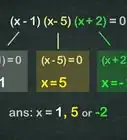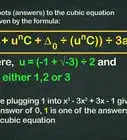wikiHow is a “wiki,” similar to Wikipedia, which means that many of our articles are co-written by multiple authors. To create this article, 111 people, some anonymous, worked to edit and improve it over time.
This article has been viewed 705,300 times.
Learn more...
Two step algebraic equations are relatively quick and easy -- after all, they should only take two steps. To solve a two step algebraic equation, all you have to do is isolate the variable by using either addition, subtraction, multiplication, or division. If you want to know how to solve two step algebraic equations in a variety of ways, just follow these steps.
Steps
Solving Equations with One Variable
-
1Write the problem. The first step to solving a two step algebraic equation is just to write the problem so you can start to visualize the solution. Let's say we're working with the following problem: -4x + 7 = 15.[1]
-
2Decide whether to use addition or subtraction to isolate the variable term. The next step is to find a way to keep "-4x" on one side and to keep the constants (whole numbers) on the other side. To do this, you'll have to do the "Additive Inverse," finding the opposite of +7, which is -7. Subtract 7 from both sides of the equation so that the "+7" on the same side as the variable term is canceled out. Just write "-7" below the 7 on one side and below the 15 on the other so the equation remains balanced.[2]
Remember the Golden Rule of Algebra. Whatever you do to one side of an equation must be done to the other side to maintain the balance. That is why 7 is subtracted from the 15 as well. We only need to subtract 7 once per side, which is why the 7 is not subtracted from the -4x as well.
Advertisement -
3Add or subtract the constant on both sides of the equation. This will complete the process of isolating the variable term. Subtracting 7 from +7 on the left side of the equation will leave no constant term (or 0) on the left side of the equation. Subtracting 7 from +15, on the right side of the equation, will leave you with 8. Therefore, the new equation is -4x = 8.[3]
- -4x + 7 = 15 =
- -4x = 8
-
4Eliminate the coefficient of the variable through division or multiplication. The coefficient is the number attached to the variable. In this example, the coefficient is -4. To remove the -4 in -4x, you'll have to divide both sides of the equation by -4. Right now, the x is being multiplied by the -4, so the opposite of this operation is division and you'll have to do it on both sides.[4]
Again, whatever you do to the equation must be done to both sides. That is why you see ÷ -4 twice.
-
5Solve for the variable. To do this, divide the left side of the equation, -4x, by -4, to get x. Divide the right side of the equation, 8, by -4, to get -2. Therefore, x = -2. You've taken two steps -- subtraction and division -- to solve this equation.[5]
Solving Equations with One Variable on Each Side
-
1Write the problem. The problem you will be working with is the following: -2x - 3 = 4x - 15. Before you proceed, make sure that both of the variables are the same. In this case, "-2x" and "4x" both have the same variable, "x," so you can move forward.
-
2Move the constants to the right side of the equation. To do this, you'll need to use addition or subtraction to eliminate the constant from the left side of the equation. The constant is -3, so you'll have to take its opposite, +3, and add this constant to both sides of the equation.[6]
- Adding +3 to the left side of the equation, -2x -3, will give you (-2x -3) + 3, or -2x on the left side.
- Adding +3 to the right side of the equation, 4x -15, will give you (4x - 15) +3, or 4x -12.
- Therefore, (-2x - 3) +3 = (4x - 15) +3 = -2x = 4x - 12
- The new equation should read -2x = 4x -12
-
3Move the variables to the left side of the equation. To do this, you'll simply have to take "the opposite" of "4x", which is "-4x," and subtract -4x from both sides of the equation.[7] On the left side, -2x - 4x = -6x, and on the right side, (4x -12) -4x = -12, so the new equation should read -6x = -12.
- -2x - 4x = (4x - 12) - 4x = -6x = -12
-
4Solve for the variable. Now that you've simplified the equation to -6x = -12, all you have to do is to divide both sides of the equation by -6 to isolate the variable x, which is currently being multiplied by -6. On the left side of the equation, -6x ÷ -6 = x, and on the right side of the equation, -12 ÷ -6 = 2. Therefore, x = 2.
- -6x ÷ -6 = -12 ÷ -6
- x = 2
Other Ways to Solve Two-Step Equations
-
1Solve two-step equations while keeping the variable on the right side. You can solve a two step equation while keeping the variable on the right side. As long as you isolate it, you'll still get the same answer. Let's take the problem, 11 = 3 - 7x. To solve it, your first step will be to combine the constants by subtracting 3 from both sides of the equation. Then, you'll have to divide both sides of the equation by -7 to solve for x. Here's how you do it:[8]
- 11 = 3 - 7x =
- 11 - 3 = 3 - 3 - 7x =
- 8 = - 7x =
- 8/-7 = -7/7x
- -8/7 = x or -1.14 = x
-
2Solve a two step equation by multiplying at the end instead of dividing. The principle for solving this type of equation is the same: use arithmetic to combine the constants, isolate the variable term, and then isolate the variable without the term. Let's say you're working with the equation x/5 + 7 = -3. The first thing you should do is subtract 7, the inverse of -3, from both sides, and then multiply both sides by 5 to solve for x. Here's how you do it:[9]
- x/5 + 7 = -3 =
- (x/5 + 7) - 7 = -3 - 7 =
- x/5 = -10
- x/5 * 5 = -10 * 5
- x = -50
Community Q&A
-
QuestionHow do I solve x/5 - 8 = 7?
 Community AnswerThe goal is to get x on one side of the equation. So add 8 to both sides of the equation; x/5 - 8 + 8 = 7 + 8; x/5 = 15. Next, multiply both sides of the equation by 5. 5 (x/5) = 15 (5). x = 75.
Community AnswerThe goal is to get x on one side of the equation. So add 8 to both sides of the equation; x/5 - 8 + 8 = 7 + 8; x/5 = 15. Next, multiply both sides of the equation by 5. 5 (x/5) = 15 (5). x = 75. -
QuestionHow would I solve 5x - 6 = 3(x-1)?
 DonaganTop Answerer5x - 6 = 3x - 3. Subtract 3x from both sides: 2x - 6 = -3. Add 6 to both sides: 2x = 3, so x = 3/2.
DonaganTop Answerer5x - 6 = 3x - 3. Subtract 3x from both sides: 2x - 6 = -3. Add 6 to both sides: 2x = 3, so x = 3/2. -
QuestionHow do I solve (3x - 2y) squared?
 DonaganTop Answerer9x² -12xy+4y². It's figured this way: (3x)(3x) = 9x². (3x)(-2y) = -6xy, and (-2y)(3x) = -6xy; (-6xy) + (-6xy) = -12xy. (-2y)(-2y) = +4y².
DonaganTop Answerer9x² -12xy+4y². It's figured this way: (3x)(3x) = 9x². (3x)(-2y) = -6xy, and (-2y)(3x) = -6xy; (-6xy) + (-6xy) = -12xy. (-2y)(-2y) = +4y².
References
- ↑ https://www.registerednursing.org/teas/solving-equations-one-variable/
- ↑ https://www.chilimath.com/lessons/intermediate-algebra/solving-two-step-equations/
- ↑ https://www.khanacademy.org/math/algebra/one-variable-linear-equations/alg1-variables-on-both-sides/v/equations-3
- ↑ https://virtualnerd.com/middle-math/equations-functions/solving-two-step/practice-solve-two-step-equation
- ↑ https://www.chilimath.com/lessons/intermediate-algebra/solving-two-step-equations/
- ↑ https://www.khanacademy.org/math/algebra/one-variable-linear-equations/alg1-two-steps-equations-intro/v/solving-equations-1
- ↑ https://www.chilimath.com/lessons/intermediate-algebra/solving-two-step-equations/
- ↑ https://www.chilimath.com/lessons/intermediate-algebra/solving-two-step-equations/
- ↑ https://flexbooks.ck12.org/cbook/ck-12-interactive-middle-school-math-7-for-ccss/section/3.7/primary/lesson/solving-two-step-equations-4424709-msm7-ccss/
About This Article
To solve two step algebraic equations with a variable on 1 side, start by using addition or subtraction to isolate the variable term. For example, if the equation is 4x + 7 = 15, isolate 4x by subtracting 7 from both sides, so that the equation becomes 4x = 8. Next, divide 4x by the number in front of the variable, so that you are left with only x. Finally, divide the other side by the same number to get x = 2. To learn more, including how to solve algebraic equations with a variable on both sides, scroll down.
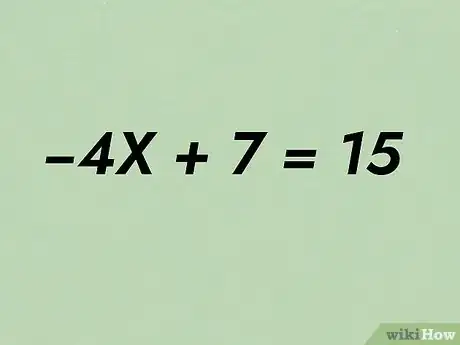
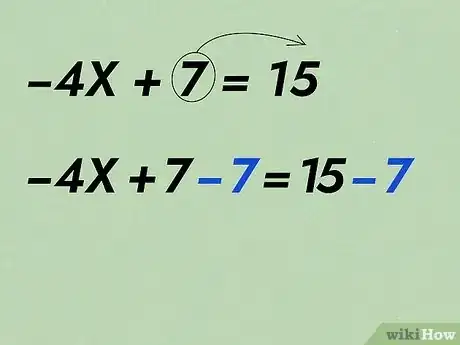
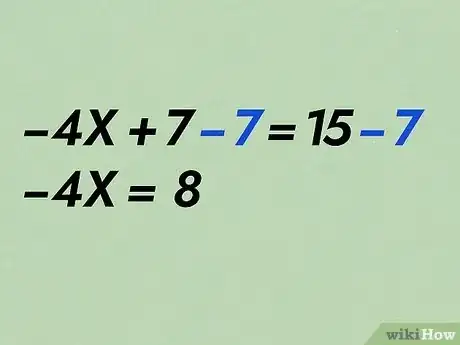
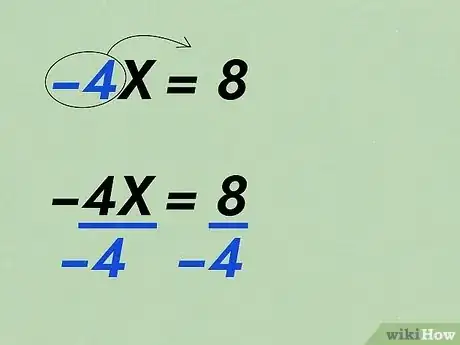

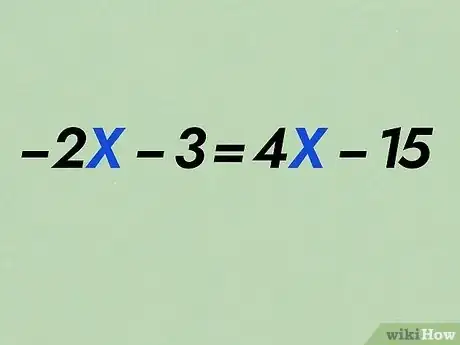
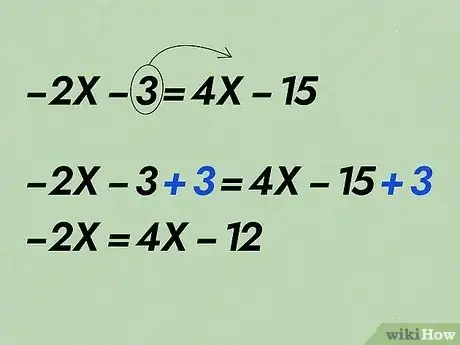
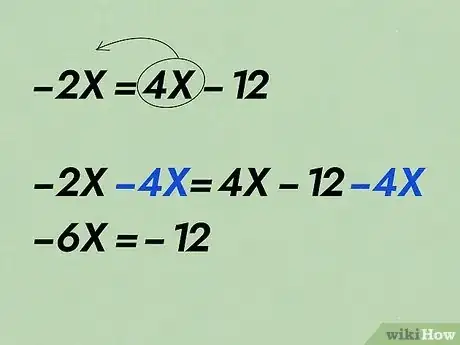
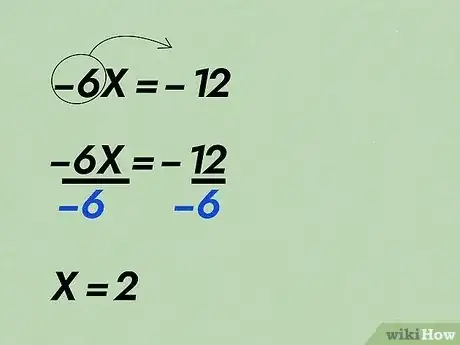
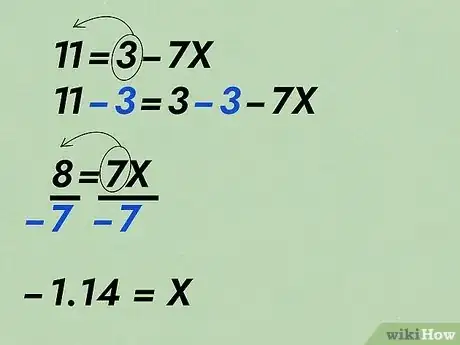
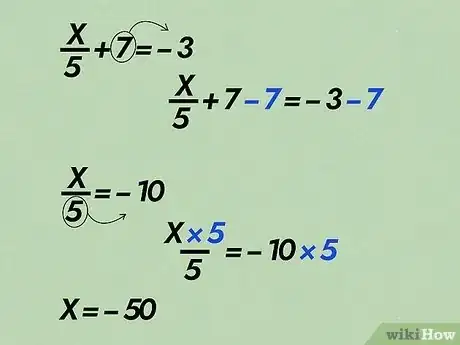
-Step-8-Version-2.webp)

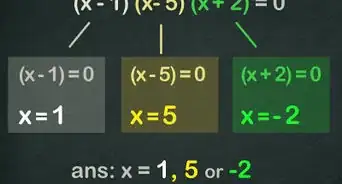
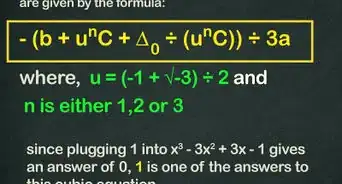


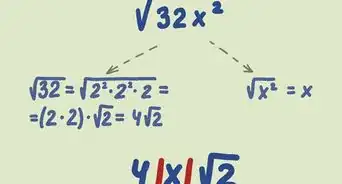
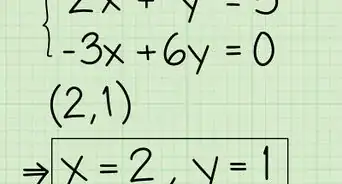

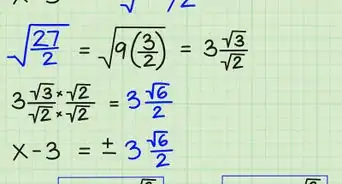

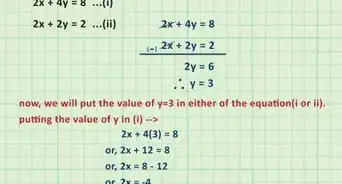
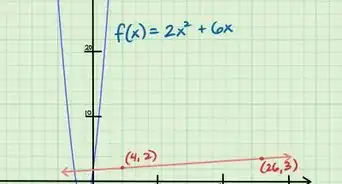
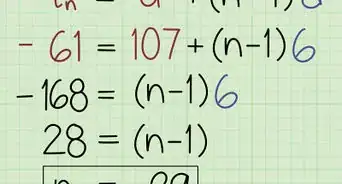






-Step-8-Version-2.webp)

